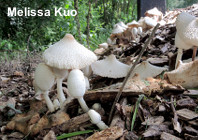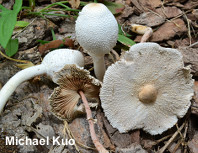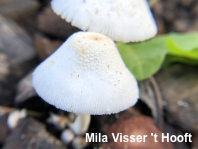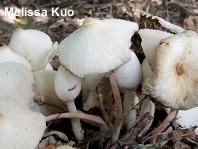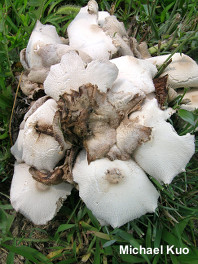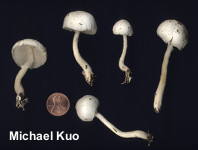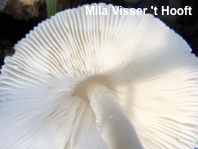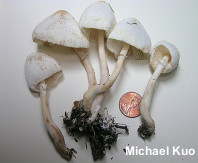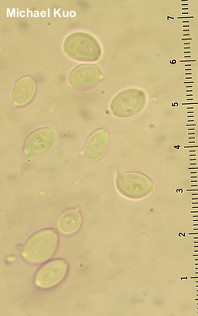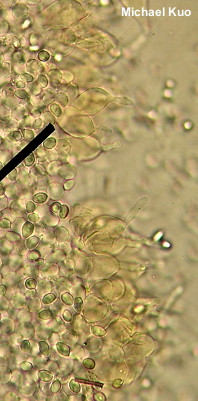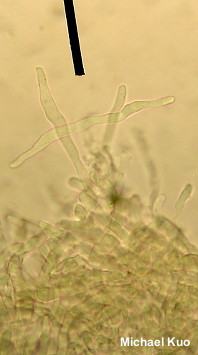| Major Groups > Gilled Mushrooms > Pale-Spored > Lepiotoid Mushrooms > Leucocoprinus cepaestipes |

|
Leucocoprinus cepaestipes [ Basidiomycota > Agaricales > Agaricaceae > Leucocoprinus . . . ] by Michael Kuo Leucocoprinus cepaestipes is a whitish lepiotoid mushroom that appears in urban settings on woodchips, as well as in woods. It features white gills that are free from the stem, a softly granular-powdery cap that has a pale grayish brown center, and a relatively bald stem with a ring. It is widely distributed in North America, and relatively common. It vies with several species of Agrocybe for the title of "Rest Area Mushroom," since traveling mushroom hunters frequently find it in woodchips surrounding the ever-present planted trees at interstate rest stops. Some people, who shall remain nameless, obviously don't know when to quit—although their traveling companions often do, and may be more than a little irritated when Leucocoprinus cepaestipes decides a few hours later to go south instead of north, merrily decomposing in its sun-warmed, backseat paper bag. While Leucocoprinus cepaestipes is not really very hard to identify, it has caused me fits over the years. At issue is the similar Leucocoprinus cretaceus, and how to distinguish them. Informed by Vellinga (2001e) and other treatments, I have gone back and forth over the years, trying to decide whether caps with faintly brownish centers count as "totally white," and whether various disarticulated branching hyphae on the cap surfaces can qualify as "bone-like in appearance." In the previous iteration of this webpage (2015), all but one of the six collections now described as Leucocoprinus cepaestipes were featured as Leucocoprinus cretaceus! Things got much easier, however, when collectors began sending me specimens for identification that turned out to be Leucocoprinus cretaceus. Assuming I am now on the right track (check back in another couple of years to make sure I haven't thrown it all to the wind again), Leucocoprinus cretaceus is pretty easily separated from Leucocoprinus cepaestipes on more easily assessed characters than its whiteness and bone-like hyphae: it is relatively rare in North America and likely to grow only in planters, potted plants, and greenhouses, especially in areas with warm climates; its young cap features soft, wart-like scales rather than granular powder; and (probably the most distinctive difference) its stem, when fresh and young, also features soft scales. Under the microscope the two species are also distinct by virtue of their cap surfaces and cheilocystidia; see the descriptions of microscopic features for details. Lepiota cepaestipes is a synonym; "cepistipes" is an alternate spelling of the species name; "cepastipes" is a misspelling. Thanks to Mila Visser 't Hooft for documenting, collecting, and preserving Leucocoprinus cepaestipes for study; her collection is deposited in The Herbarium of Michael Kuo. Description: Ecology: Saprobic; growing in clusters in woodchips, cultivated soil, gardens, and so on— also occasionally appearing in woods, especially in the vicinity of stumps and deadwood; spring through fall—and over winter in warm climates; widely distributed in North America. The illustrated and described collections are from California and Illinois. Cap: 3–9 cm; egg-shaped or nearly round when young, becoming convex to broadly convex with a sharp or shallow central hump, or nearly flat; dry; powdery with soft, whitish granules; whitish to pale brownish; usually featuring a grayish brown center, even when young (but not infrequently nearly pure white in the button stage); the margin becoming distinctly lined. Gills: Free from the stem; close or nearly crowded; short-gills frequent; white, becoming pinkish to slightly brownish with old age. Stem: 6–9 cm long; 4–10 mm thick; more or less equal, but swollen slightly near the bottom; bald; white, discoloring and slowly bruising yellowish, then pinkish to brownish; often turning pinkish (the color of red onion skin) with age; with a bracelet-like, white ring that quickly collapses and often disappears; basal mycelium white; attached to whitish rhizomorphs. Flesh: Whitish; very thin; unchanging when sliced. Odor: Not distinctive. Chemical Reactions: KOH negative on cap surface. Spore Print: White. Microscopic Features: Spores (5–) 7–11 (–13) x 4–7 µm; ellipsoid; smooth; with a tiny pore; thick-walled; hyaline in KOH; dextrinoid. Basidia 4-sterigmate. Pavement cells present. Cheilocystidia 40–85 x 7.5–20 µm; clavate to lageniform; often becoming rostrate with a long, flexuous, irregular neck; thin-walled; smooth; hyaline in KOH. Pleurocystidia not found. Pileipellis a poorly defined cutis of elements 2.5–5 µm wide, with many exserted terminal cells 50–100 x 3–7.5 µm, cylindric to subfusiform or fusiform, smooth, thin-walled, hyaline to brownish or yellowish in KOH. Pileipellis over the glabrous disc a subcellular layer from which arise widely cylindric elements with rounded apices, 35–60 x 5–7.5 µm, smooth, hyaline in KOH. REFERENCES: (Sowerby, 1797) Patouillard, 1889. (Saccardo, 1887; Kauffman, 1918; H. V. Smith, 1954; Smith, Smith & Weber, 1979; H. V. Smith, 1981; H. V. Smith, 1982; Arora, 1986; Phillips, 1991/2005; Lincoff, 1992; Metzler & Metzler, 1992; Breitenbach & Kränzlin, 1995; Vellinga, 2001e; Roody, 2003; McNeil, 2006; Miller & Miller, 2006; Vellinga, 2009; Buczacki et al., 2013; Kuo & Methven, 2014; Desjardin, Wood & Stevens, 2015; Woehrel & Light, 2017; Baroni, 2017; Lange, 2018; Kibby, 2020; McKnight et al., 2021.) Herb. Kuo 08230201, 08010302, 08160502, 07260701, 08221402, 07301605, 09182003. This site contains no information about the edibility or toxicity of mushrooms. |
© MushroomExpert.Com |
|
Cite this page as: Kuo, M. (2022, February). Leucocoprinus cepaestipes. Retrieved from the MushroomExpert.Com Web site: http://www.mushroomexpert.com/leucocoprinus_cepaestipes.html |
